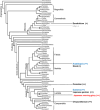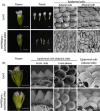A petal-specific InMYB1 promoter from Japanese morning glory: a useful tool for molecular breeding of floricultural crops
- PMID: 25923400
- PMCID: PMC11388897
- DOI: 10.1111/pbi.12389
A petal-specific InMYB1 promoter from Japanese morning glory: a useful tool for molecular breeding of floricultural crops
Abstract
Production of novel transgenic floricultural crops with altered petal properties requires transgenes that confer a useful trait and petal-specific promoters. Several promoters have been shown to control transgenes in petals. However, all suffer from inherent drawbacks such as low petal specificity and restricted activity during the flowering stage. In addition, the promoters were not examined for their ability to confer petal-specific expression in a wide range of plant species. Here, we report the promoter of InMYB1 from Japanese morning glory as a novel petal-specific promoter for molecular breeding of floricultural crops. First, we produced stable InMYB1_1kb::GUS transgenic Arabidopsis and Eustoma plants and characterized spatial and temporal expression patterns under the control of the InMYB1 promoter by histochemical β-glucuronidase (GUS) staining. GUS staining patterns were observed only in petals. This result showed that the InMYB1 promoter functions as a petal-specific promoter. Second, we transiently introduced the InMYB1_1 kb::GUS construct into Eustoma, chrysanthemum, carnation, Japanese gentian, stock, rose, dendrobium and lily petals by particle bombardment. GUS staining spots were observed in Eustoma, chrysanthemum, carnation, Japanese gentian and stock. These results showed that the InMYB1 promoter functions in most dicots. Third, to show the InMYB1 promoter utility in molecular breeding, a MIXTA-like gene function was suppressed or enhanced under the control of InMYB1 promoter in Arabidopsis. The transgenic plant showed a conspicuous morphological change only in the form of wrinkled petals. Based on these results, the InMYB1 promoter can be used as a petal-specific promoter in molecular breeding of floricultural crops.
Keywords: Ipomoea nil; MYB; floricultural crops; molecular breeding; petal-specific promoter.
© 2015 Society for Experimental Biology, Association of Applied Biologists and John Wiley & Sons Ltd.
Figures







References
-
- Angiosperm Phylogeny Group . (2009) An update of the Angiosperm Phylogeny Group classification for the orders and families of flowering plants: APG III. Bot. J. Linn. Soc. 161, 105–121.
-
- Baumann, K. , Perez‐Rodriguez, M. , Bradley, D. , Venail, J. , Bailey, P. , Jin, H. , Koes, R. , Roberts, K. and Martin, C. (2007) Control of cell and petal morphogenesis by R2R3 MYB transcription factors. Development, 134, 1691–1701. - PubMed
-
- Benfey, P.N. and Chua, N.H. (1990) The cauliflower mosaic virus‐35S promoter – combinatorial regulation of transcription in plants. Science, 250, 959–966. - PubMed
-
- Christensen, A.H. and Quail, P.H. (1996) Ubiquitin promoter‐based vectors for high‐level expression of selectable and/or screenable marker genes in monocotyledonous plants. Transgenic Res. 5, 213–218. - PubMed
-
- Clough, S.J. and Bent, A.F. (1998) Floral dip: a simplified method for Agrobacterium‐mediated transformation of Arabidopsis thaliana . Plant J. 16, 735–743. - PubMed
Publication types
MeSH terms
Substances
LinkOut - more resources
Full Text Sources
Research Materials

